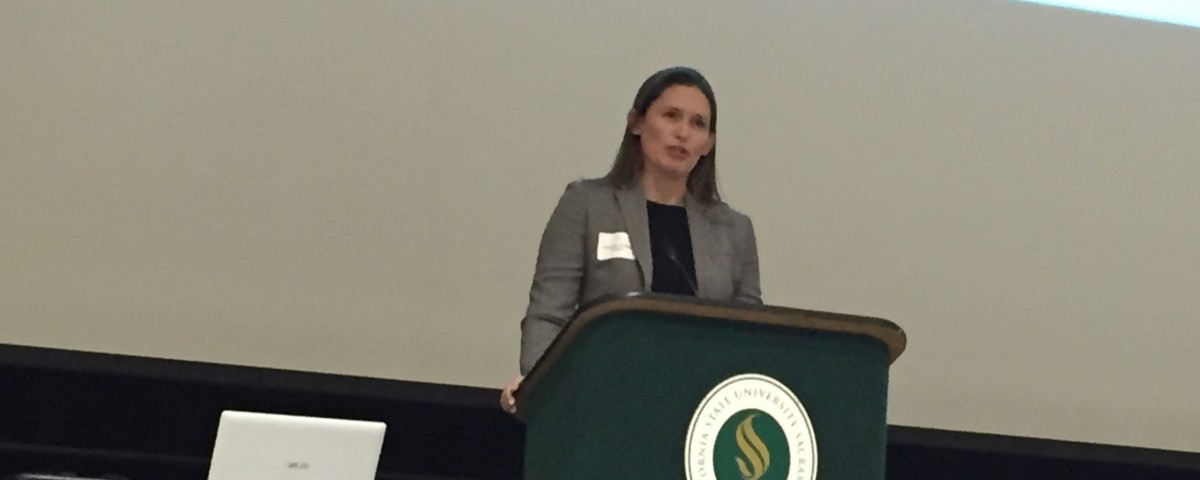Modern-day slavery: Understanding the intersection of forced marriage and human trafficking

The AHA Foundation’s Interim Executive Director Amanda Parker recently spoke at the Intersections of Human Trafficking Conference hosted by My Sister’s House, a domestic violence organization in Sacramento, California. More than 300 professionals who work with victims of human trafficking joined the conference. In her speech, Amanda explained how forced marriage and human trafficking cases can overlap and why it is important for professionals from both fields who work with the victims to be aware of this intersection. Here are some of the concepts touched upon during her speech:
The idea that a person may be bought and sold as part of a transaction is not a new one. When people consider modern-day slavery, human trafficking is what immediately comes to mind. But rarely do they think of forced marriage.
Two overarching factors in both forced marriage and human trafficking are:
- The absence of choice for the victim.
- An exchange of currency to complete the transaction.
Our experience at the AHA Foundation with forced marriage cases shows a definite overlap between trafficking and forced marriage. Consider the following scenarios:
A family in need of a caretaker for their ailing, elderly mother make what seems to them to be a sensible decision; they pay a fee to a man who then hands over his teen daughter – we’ll call her Fiona – to serve as the live-in nurse, cook and maid for the elderly mother and the extended family who all live together in the same compound. Fiona is not given a choice in the matter, her father decides it will be, he is given payment, and it is done. Thereafter, Fiona’s days begin before dawn, when she is up cooking breakfast for the family, and end late, when she finishes cleaning long after dark. She receives no payment for this exhausting work.
The scenario above is one example how a human trafficking transaction might occur.
Now consider that the eldest son is the person who seeks out Fiona to care for his ailing mother and become his wife. His payment to Fiona’s father is deemed a bride price, and as the completion of this transaction with Fiona’s father, he marries her. Now the scenario has shifted – the girl is a victim of a forced marriage rather than human trafficking. To Fiona, the outcome has shifted – in addition to serving an unwanted husband and his family, she is sexually abused and raped.
In a different scenario, a man visiting Pakistan for a short time decides he will find a wife for the duration of his trip. Through his connections, he learns that a girl – we’ll call her Guita – is an eligible bride; Guita’s family is willing, for the right bride price, to hand her over to be his wife. While her new husband is in Pakistan, he repeatedly rapes her, and he considers his behavior justified, now that she is his wife. When his trip is over, he returns home, leaves Guita and never sees her again. Although Guita is clearly a victim of forced marriage, her story is obviously similar to a case of sex trafficking, where a girl is given to a man for the purposes of sex in exchange for money. Guita’s story illustrates another way in which there may be a significant overlap between a case of human trafficking and a case of forced marriage.
In a situation of forced marriage, similar to human trafficking, there is generally some sort of currency involved. That currency may not always be actual money, as it is in the case of a bride price or dowry. A victim may be given to her new spouse in exchange for immigration benefits for family members, or in other cultural traditions, the bride’s family may offer immigration benefits to the husband and his family as part of the transaction.
Other forms of currency that may be used in a forced marriage are not as obvious. Examples include access to a family alliance that is given because of the marriage, which may be quite valuable in warring societies, or to those in agrarian communities. Some girls are traded to a husband as payment for a wrongdoing committed by one of the men in her own family.
Like forced marriage, there is no official estimate* of how many people in the US are victims of human trafficking. Polaris Project, the organization that runs the National Human Trafficking Hotline, estimates the number of trafficking victims in the US to be in the hundreds of thousands. The number of forced marriages is estimated at 1,500 each year.
The lines between forced marriage and human trafficking often blur. In these instances, it is critical that professionals in both fields work together and share resources, best practices, and intelligence in order to prevent these major violations of fundamental human rights. Better coordination and higher levels of awareness around both types of abuse will help prevent these crimes and lead victims to safety.
Whether a girl is being sold into a marriage or being sold into domestic servitude, the resulting life is devoid of hope, choice and is similarly bleak.

